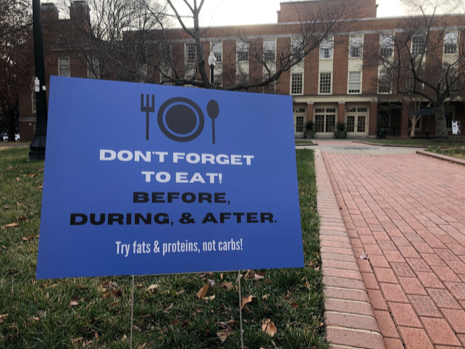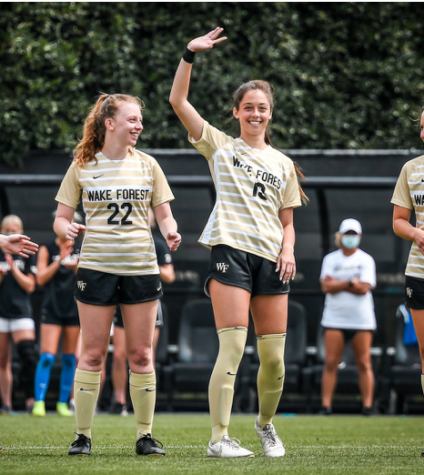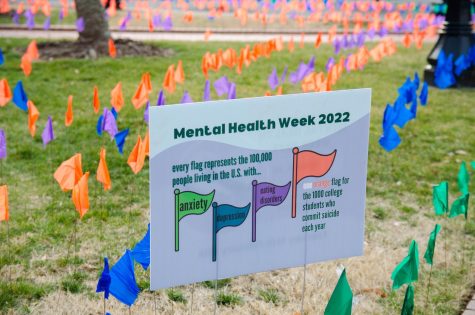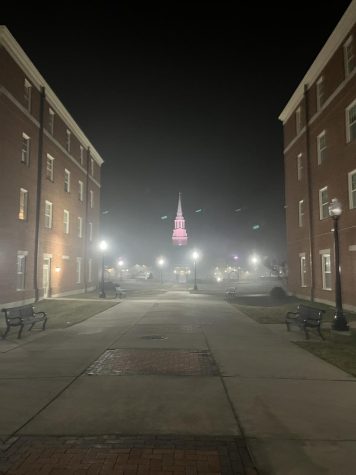Exploring eating disorders at Wake Forest
The prevalence of eating disorders at Wake Forest can be addressed through social and administrative support

A sign in Tribble Courtyard reminds students to eat during the first semester finals week. Disordered eating constitutes a major issue on the Wake Forest campus.
January 13, 2022
Work. Study. Exercise. Party. Repeat. That is the ever-present reality of college life at Wake Forest University according to many students.
Binding together that cycle is the pressure to be great — not just at what you value, but at everything. Worst of all, the seeming requirement of reaching that level of personal, academic, and social success has infiltrated one of the most fundamental needs of a healthy lifestyle to the wayside: eating.
On a campus consumed by a culture of perfectionism that has only been exacerbated by a global pandemic, eating disorders and disordered eating are affecting more and more students each year.
“Eating disorders and disordered eating are prevalent across colleges and universities in general,” said Coordinator of Eating Disorder Prevention Services at the Counseling Center Dr. Emily Palmieri. “With that said, the last Healthy Minds survey and American College Health Assessment data reported Wake Forest as having higher than average reports in disordered eating.”
The prevalence of eating-related issues at Wake Forest is no secret to its students, faculty or staff. Yet their presence has only proliferated, leaving some feeling confused as to the seeming lack of social and administrative support.
A Cultural Issue
Wake Forest’s high-achieving community is a source of pride; however, the pressure it can generate may have substantial consequences for its members.
While “Work Forest”’s work hard-play hard mindset may be evident to students from the beginning, academic pressures represent only one part of the many challenges students face in their efforts to impress.
“It’s easy to compare yourself to other girls on campus,” a female junior who wished to remain anonymous said. “Just walking around. you see girls who are super, super skinny. The visibility of what other girls look like can become overwhelming.”
The European thin ideal is predominant across campus, according to Palmieri, and the consequences of eating disorders are clear.
“As a therapist, I hear it is difficult for students to feel a sense of belonging and acceptance if their genetics or survival strategies do not match with the perceived norm,” Palmieri said.
The pressure to conform to a specific body image affects many members of the community, but being physically surrounded by a thin body ideal presents heightened challenges.
“When I’m home, I don’t care what I look like,” the same junior as above said. “I’m walking everyday and active, but I’m never doing it for how I look. But when I get here, I immediately start feeling self-conscious. It’s such a switch. I compare myself to every girl on campus and realize I don’t have the typical body of a Wake Forest girl.”
A pervasive sense of intra-community comparison was mentioned by multiple Wake Forest women who have challenging relationships with food as being a driver of disordered eating. However, struggles with food and body images are not exclusive to female-identifying students at Wake Forest.
“I’ve seen so many more guys in the gym this year,” junior Conner Chapman said. “It definitely feels like there can be pressure, though. I think everyone suffers from challenges at some level when they look in the mirror, whether it’s wanting more muscle or less fat, and that changes the way we go about eating, too.”
The Radical Balancing Act
Irregular patterns of eating have come to play a substantial role in intentional and unintentional efforts to fulfill the expectations of perfection that riddle the Wake Forest community.
Party-going and alcohol consumption dominate the Wake Forest social scene, with 78.4% of students choosing to drink according to the Spring 2020 National Collegiate Health Assessment. Subsequently, enjoying parties to the fullest while remaining body-conscious adds even more strain to the tumultuous relationship many have with eating.
“I cannot tell you how many times I heard the sentence ‘I’m not going to eat anything today so I can get drunk off of one White Claw tonight and not look bloated when I go out,’” said a 2020 graduate of Wake Forest who explored eating disorders at Wake Forest through documentary filmmaking. “The going-out culture at Wake Forest is toxic, and it glorifies the idea of not eating to look skinny or get drunk faster.”
Parties heighten the visibility of the already prominent thin ideal. Often filled with more revealing outfits, the pressure to conform to body image standards is only exacerbated.
The reasoning behind the modifications in eating behavior varies for different students. Some eat little-to-no food to get drunk faster. Others chose not to eat in order to appear skinnier when going out.
“It’s all a mental tradeoff,” the anonymous junior said. “You think, ‘now I can do this because I did that,’ whether it’s burning calories in the gym to drink them back later or eating less to allow yourself to dress a certain way.”
While this behavior has become entrenched in Wake Forest culture, it falls firmly under the umbrella of disordered eating – which encompasses eating modifications in response to social self-representation, according to the Contemporary Psychoanalysis Group.
Unfortunately, recognition of unhealthy or disordered behaviors does not make them easier to overcome. Even among social circles who claim to have healthy relationships with food, pressure to conform lingers along with a desire for better administrative support.
Administrative Action
As eating-related issues have proliferated, so has the demand on the offices and teams working to prevent or mitigate any damage they may be causing to the community.
“The University Counseling Center, the Safe Office and the Student Health Service have experienced higher than usual incidents, as have offices that typically would not have eating disorders brought to them by students — and others — including the Center for Learning Access and Student Success, the Chaplain’s office, Campus Ministers and faculty members,” Palmieri said.
In regards to responding to student wellbeing in relation to eating disorders and disordered eating, the Counseling Center offers “group therapy, blind weight checks through Student Health Services, and some individual therapy services,” according to Dr. Palmieri.
Fortunately, dining services are also looking to respond to the increasingly challenging relationships with food on campus and seem to be receiving encouraging feedback.
“All our messages are positive and inclusive – we tell our story and offer information and experiences without negativity,” Madison Fishler, the health and wellness manager for Harvest Table, which oversees dining at Wake Forest, said. “We aim to celebrate all types of food and encourage a variety of food choices. We don’t take away food options to limit the consumer choices, we are always looking to add more food and beverage options. We provide education on wellbeing practices in a non-judgmental and positive way that empowers others as opposed to shaming people’s choices.
The prevalence of eating disorders and disordered eating at Wake Forest does not appear to be going anywhere, barring an immediate cultural shift and a dramatic expansion of resources available to students. Yet even amidst the seemingly unending slew of expectations and reasons for stress, there remains room for optimism.
“The amount of people who reached out and said they had struggled with something similar to me was overwhelming,” the 2020 graduate said. “I got to talk to people who trusted me with their stories, and it was a really warming thing to get to open up to people, even complete strangers, about a shared experience.”
This story is an abridged version of a full story that will appear online.























Leane Doggett Turner • Jan 21, 2022 at 9:15 am
Thank you for a start in addressing this critical national health issue. I was first exposed to ED as an undergrad at Wake in the 1980s. Unfortunately this issue is even more pervasive with social media and the pressures of society and the pandemic. As an alumni will enthusiastically financially support with campus efforts to effectively address the causes, educate and support.